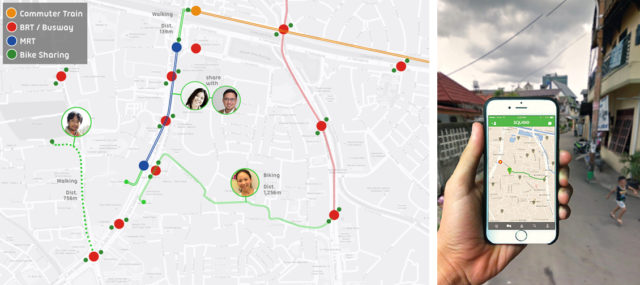Why the New Cities Summit Triggered a New App for Jakarta Commuters
juillet 6, 2015 — Uncategorized
Growing up in Jakarta, one of the most vibrant yet congested cities in the world, I used to be highly dependent on cars for daily commuting. However, having moved countries several times over the past four years, I have come to realize that nothing beats moving around the city by foot – it gives a great sense of freedom and is far more enjoyable.

Jakarta: A Walkable City?
Even in Jakarta, where cars rule the roads, walking has the potential to be a faster and more practical alternative way of daily commuting, if successfully combined with public transport or taxis. By adopting this kind of “multi-modal” approach to commuting, I have far more liberty. I can speed up or slow down as I wish, fit down any outdoor or indoor pathways, reroute anytime or escape traffic congestion when necessary.
Every day, at least 15 million commutes are completed on foot or by bike in the Jakarta Greater Area, up to 40 per cent of the total modal shares.1 This number has also increased by 6 per cent in the last decade, gaining popularity among young and professional Jakarta residents.
Unfortunately, Jakarta’s existing transportation landscape can be daunting and exhausting. Most of our formal urban sidewalks and bike lanes are located along motorized roadways. On top of the stress, danger and pollution from motorized traffic, finding a pedestrian shortcut to a destination in Jakarta can be a challenge. Further, since Jakarta has been car-centric for so long, we citizens lack the information as well as the motivation to build a mental map of viable walkable and bikeable routes within our city.
Tapping into the Potential of Urban Kampongs
Yet, despite heavy reliance on cars, Jakarta holds a whole network of hidden, low-rise pockets that we call urbankampongs (villages). They are everywhere, located strategically between primary urban roadways, decentralized nearby our home, work places, and public transport network.
Many of the kampongs have been developed into modern residential, commercial, or even superblock complexes, while some have persisted in their original form. Those that have remained retain their organically shaped neighborhood roads and passageways, which are generally separated from major urban thoroughfares.
Partly covered by greenery, these areas are less polluted and a have a milder temperature than the bustling main roads. By nature, kampong roadways are often utilized as short-cut accesses – referred to in by locals as Jalan Tikus – to reduce travel time or to avoid the hustle-bustle of busy Jakarta. However, routes through urban kampongs are generally unmapped and solely known to kampong-dwellers or frequent passers-by.
I got together with some other Jakarta-based innovators to try and solve this issue. Our desire is for Jakarta commuters to better utilize these forgotten “rat-running trails” hidden behind Jakarta’s imposing network of wide, busy roads and high-rise buildings. The concept for Squee mobile app was born out of this desire.
Enabled by GPS-based mobile technology and crowdsourced information mapping, Squee aims to unify pedestrians and biking communities in Jakarta. The app encourages them to travel together in groups and helps commuters plan and navigate walkable, or bikeable rat-running routes.
By squeeing together, people can share real-time information and enjoy a more pleasant commute. Most importantly, they help keep these routes safe by embracing a new kind of mobility that we call ratwalk-sharing.

Jakarta Urban Challenge: the Beginning of our Squee Journey
Winning the Jakarta Urban Challenge at the New Cities Summit 2015 was truly a significant milestone. My three co-founders and I can now kick-start Squee mobile app as a tech-startup. Being part of the Summit has brought us into contact with a global collaborative movement of urban leaders and thinkers.
The opportunity has given us the possibility of accessing valuable input and support from international and local urban experts, including the Governor of Jakarta, who joined NewCities’ Chairman to award us our Prize on June 10. The week following the Summit, the Governor invited us to join him for lunch to discuss our project in more detail and explore the possibilities for future collaboration between us.
With the support from Jakarta City Government, Squee could also be integrated into Smart City Jakarta program. Thus, the Squeeians – our users, would be equipped with an integrated timetable and navigating information for all different types of transport available in Jakarta’s public transport system. Access to this information via Squee will enhance active transport to a more extensive transit-oriented level in the future.
Our ratwalk-sharing concept has a social goal to bring back the good function of roads and urban kampongs. Aiming to revisit walking and biking as feasible alternative ways of commuting, Squee will not only improve kampong navigation but also help the Squeeians to experience and recognize different information, details, and puzzles of everyday streetscapes. This will eventually create a four-dimensional mental map of Jakarta that cannot be experienced when travelling along the primary roads.
Squee was just one of many answers to Jakarta Urban Challenge, and our journey has just begun. But we believe that encouraging active mobility through smart and contextual innovation is a global urban challenge for everyone. So when the next challenge comes to you, what would you do to create a better mobility in your city?